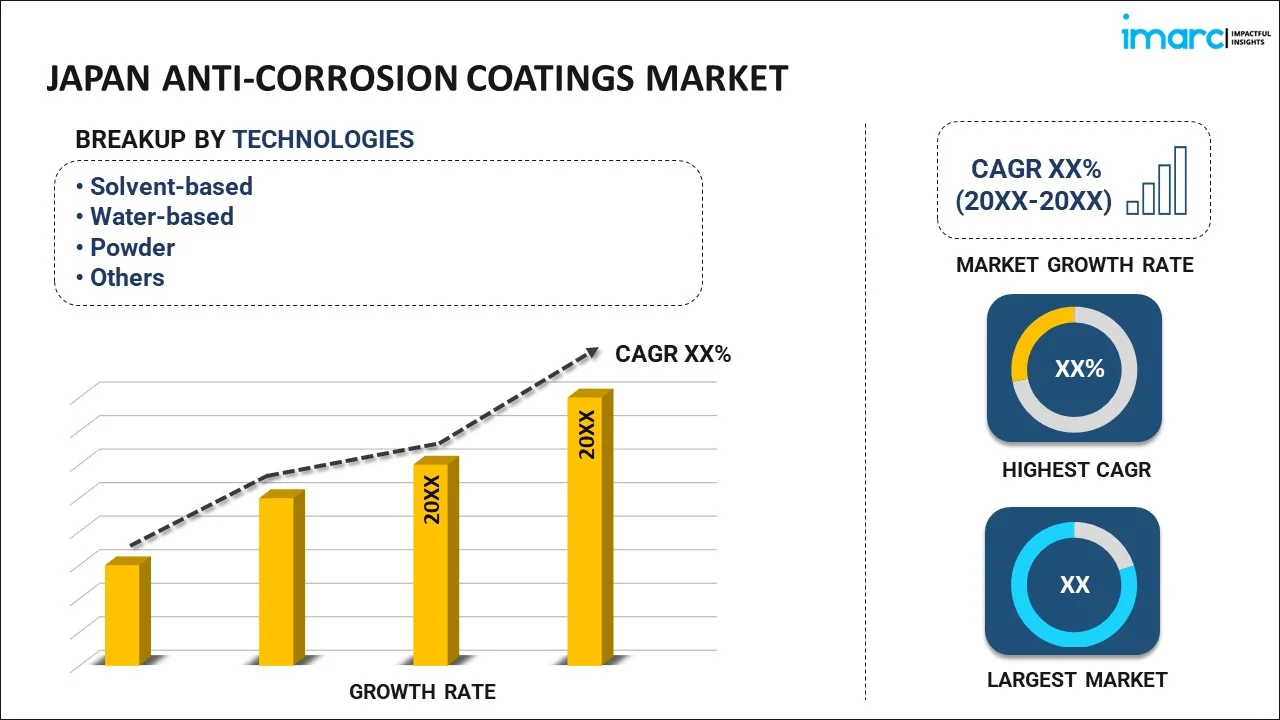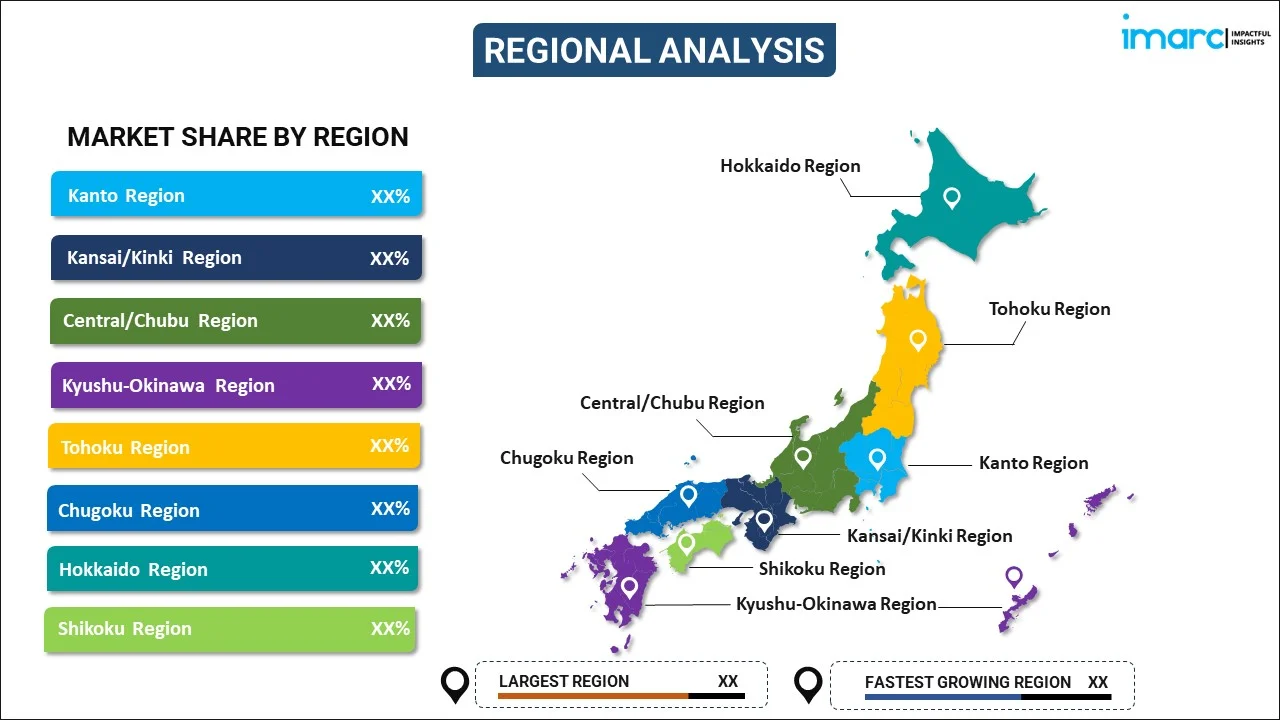
Japan Anti-Corrosion Coatings Market Report by Technology (Solvent-based, Water-based, Powder, and Others), Material (Acrylic, Alkyd, Polyurethane, Epoxy, Zinc, and Others), Application (Oil and Gas, Marine, Building and Construction, Automotive and Rail, Aerospace and Defense, and Others), and Region 2025-2033
Market Overview:
The Japan anti-corrosion coatings market size reached USD 2,133.6 Million in 2024. Looking forward, IMARC Group expects the market to reach USD 3,036.8 Million by 2033, exhibiting a growth rate (CAGR) of 4% during 2025-2033. The increasing product utilization in the automotive and construction sectors, the incorporation of nanotechnology in coatings, ongoing research and development (R&D) activities, the implementation of various government regulations and standards, and the growing awareness of sustainability and the need for eco-friendly products represent some of the key factors driving the market.
|
Report Attribute
|
Key Statistics
|
|---|---|
|
Base Year
|
2024 |
|
Forecast Years
|
2025-2033 |
|
Historical Years
|
2019-2024
|
| Market Size in 2024 | USD 2,133.6 Million |
| Market Forecast in 2033 | USD 3,036.8 Million |
| Market Growth Rate (2025-2033) | 4% |
Anti-corrosion coatings refer to specialized coatings applied to surfaces to protect them from corrosion. They are formulated using various materials, such as epoxy, polyurethane, zinc, and acrylic. Anti-corrosion coatings are available in various types, including organic, inorganic, and hybrid coatings. They are characterized by their unique properties, like excellent adhesion, water resistance, and chemical resistance. Anti-corrosion coatings are widely utilized in various applications, such as automotive, marine, oil and gas, construction, power generation, and industrial machinery. They offer a wide range of benefits, including extended equipment life, reduced maintenance costs, and improved aesthetics. In addition to this, anti-corrosion coatings are also known for their versatility, eco-friendliness, cost-effectiveness, and efficiency in extreme conditions.
Japan Anti-Corrosion Coatings Market Trends:
The increasing demand for anti-corrosion coatings in the automotive sector to extend the lifespan of vehicles and their components is creating a positive outlook for the market growth. Moreover, the growing shipping and marine industry in Japan, facilitating widespread product adoption for protecting ships and underwater structures from corrosive seawater, is providing a thrust to the market growth. Along with this, the rising utilization of anti-corrosion coating in the construction industry due to rapid urbanization and modernization is favoring the market growth. In line with this, the increasing product application to protect structural steel, concrete, and other construction materials from degrading over time is anticipated to drive the market growth. In addition to this, the expanding manufacturing industries like the electronics sector, prompting the adoption of coatings to safeguard intricate components from corrosion and enhance their durability, is bolstering the market growth. Additionally, the incorporation of nanotechnology in coatings, leading to the development of more efficient and long-lasting solutions, is providing a considerable boost to the market growth. In confluence with this, the growing coating application in harsh environments, such as high levels of salt or extreme temperatures, is supporting the market growth. Apart from this, the ongoing research and development (R&D) activities, resulting in coatings with self-healing properties, are acting as a growth-inducing factor. Furthermore, the rising focus on clean energy, leading to an increasing need for coatings that protect wind turbines, solar panels, and other related equipment from the elements to ensure efficiency and longevity, is creating a positive outlook for the market growth. Additionally, the implementation of various government regulations and standards advocating for quality and safety across industries, which is compelling businesses to adopt anti-corrosion coatings, is accelerating the market growth. Besides this, the growing awareness of sustainability and the need for eco-friendly products, encouraging manufacturers to produce coatings with low volatile organic compound (VOC) emissions, is positively influencing the market growth across the country.
Japan Anti-Corrosion Coatings Market Segmentation:
IMARC Group provides an analysis of the key trends in each segment of the market, along with forecasts at the country level for 2025-2033. Our report has categorized the market based on technology, material, and application.
Technology Insights:

- Solvent-based
- Water-based
- Powder
- Others
The report has provided a detailed breakup and analysis of the market based on the technology. This includes solvent-based, water-based, powder, and others.
Material Insights:
- Acrylic
- Alkyd
- Polyurethane
- Epoxy
- Zinc
- Others
A detailed breakup and analysis of the market based on the material have also been provided in the report. This includes acrylic, alkyd, polyurethane, epoxy, zinc, and others.
Application Insights:
- Oil and Gas
- Marine
- Building and Construction
- Automotive and Rail
- Aerospace and Defense
- Others
The report has provided a detailed breakup and analysis of the market based on the application. This includes oil and gas, marine, building and construction, automotive and rail, aerospace and defense, and others.
Regional Insights:

- Kanto Region
- Kansai/Kinki Region
- Central/ Chubu Region
- Kyushu-Okinawa Region
- Tohoku Region
- Chugoku Region
- Hokkaido Region
- Shikoku Region
The report has also provided a comprehensive analysis of all the major regional markets, which include Kanto Region, Kansai/Kinki Region, Central/ Chubu Region, Kyushu-Okinawa Region, Tohoku Region, Chugoku Region, Hokkaido Region, and Shikoku Region.
Competitive Landscape:
The market research report has also provided a comprehensive analysis of the competitive landscape. Competitive analysis such as market structure, key player positioning, top winning strategies, competitive dashboard, and company evaluation quadrant has been covered in the report. Also, detailed profiles of all major companies have been provided.
Japan Anti-Corrosion Coatings Market Report Coverage:
| Report Features | Details |
|---|---|
| Base Year of the Analysis | 2024 |
| Historical Period | 2019-2024 |
| Forecast Period | 2025-2033 |
| Units | Million USD |
| Scope of the Report | Exploration of Historical and Forecast Trends, Industry Catalysts and Challenges, Segment-Wise Historical and Predictive Market Assessment:
|
| Technologies Covered | Solvent-based, Water-based, Powder, Others |
| Materials Covered | Acrylic, Alkyd, Polyurethane, Epoxy, Zinc, Others |
| Applications Covered | Oil and Gas, Marine, Building and Construction, Automotive and Rail, Aerospace and Defense, Others |
| Regions Covered | Kanto Region, Kansai/Kinki Region, Central/ Chubu Region, Kyushu-Okinawa Region, Tohoku Region, Chugoku Region, Hokkaido Region, Shikoku Region |
| Customization Scope | 10% Free Customization |
| Post-Sale Analyst Support | 10-12 Weeks |
| Delivery Format | PDF and Excel through Email (We can also provide the editable version of the report in PPT/Word format on special request) |
Key Questions Answered in This Report:
- How has the Japan anti-corrosion coatings market performed so far and how will it perform in the coming years?
- What has been the impact of COVID-19 on the Japan anti-corrosion coatings market?
- What is the breakup of the Japan anti-corrosion coatings market on the basis of technology?
- What is the breakup of the Japan anti-corrosion coatings market on the basis of material?
- What is the breakup of the Japan anti-corrosion coatings market on the basis of application?
- What are the various stages in the value chain of the Japan anti-corrosion coatings market?
- What are the key driving factors and challenges in the Japan anti-corrosion coatings?
- What is the structure of the Japan anti-corrosion coatings market and who are the key players?
- What is the degree of competition in the Japan anti-corrosion coatings market?
Key Benefits for Stakeholders:
- IMARC’s industry report offers a comprehensive quantitative analysis of various market segments, historical and current market trends, market forecasts, and dynamics of the Japan anti-corrosion coatings market from 2019-2033.
- The research report provides the latest information on the market drivers, challenges, and opportunities in the Japan anti-corrosion coatings market.
- Porter's five forces analysis assist stakeholders in assessing the impact of new entrants, competitive rivalry, supplier power, buyer power, and the threat of substitution. It helps stakeholders to analyze the level of competition within the Japan anti-corrosion coatings industry and its attractiveness.
- Competitive landscape allows stakeholders to understand their competitive environment and provides an insight into the current positions of key players in the market.
Need more help?
- Speak to our experienced analysts for insights on the current market scenarios.
- Include additional segments and countries to customize the report as per your requirement.
- Gain an unparalleled competitive advantage in your domain by understanding how to utilize the report and positively impacting your operations and revenue.
- For further assistance, please connect with our analysts.
 Inquire Before Buying
Inquire Before Buying
 Speak to an Analyst
Speak to an Analyst
 Request Brochure
Request Brochure
 Request Customization
Request Customization




.webp)




.webp)












